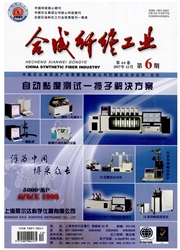

 中文摘要:
中文摘要:
针对大型连续PTA直接酯化法PET工艺过程装置,以AspenPlus和PolymersPlus为模型开发工具,建立了以反应和传质过程机理为基础的稳态模型。结果表明:该模型中包括了酯化反应、缩聚反应、二甘醇生成反应、链降解反应和乙醛生成等主副反应,且考虑了端羧基对酯化反应的自催化效应;更重要的是模型考虑了酯化阶段PTA在酯化反应器中的溶解过程和终缩聚阶段小分子的脱挥,并建立了小分子脱挥的传质系数与缩聚反应器内聚合度、黏度、温度和搅拌器转速等的关联;在此模型基础上模拟研究了第一酯化反应操作温度对各反应器出口指标的影响,指出酯化段的酯化率有一个适宜的控制范围。
 英文摘要:
英文摘要:
With Aspen Plus and Polymers Plus as modeling platforms, a steady-state model was built for industrial continuous PTA direct esterification into PET process based on reaction kinetics and mass transfer mechanism. The results showed that the model simulated the main and side reactions including esterification, polycondensation, diethylene glycol formation, polymer seg- ment degradation and acetaldehyde formation and also involved the catalytic effect of carbexyl end group on esterfication; moreo- ver, the dissolution of PTA in esterification reactor during the esterification stage and the devolatilization of small molecules during the final polycondensation stage were particularly taken into consideration; and the correlationship between the mass transfer coefficient of devolatilization and the polymerization degree, viscosity, temperature and agitation rate in the polycondensation re- actor was also established. The effect of the operation temperature of the first esterification reactor on the process index at the exits of all reactors was studied with this model. It was pointed out that the esterification ratio of esterifieation process should be controlled within a proper range.
 同期刊论文项目
同期刊论文项目
 同项目期刊论文
同项目期刊论文
 期刊信息
期刊信息
